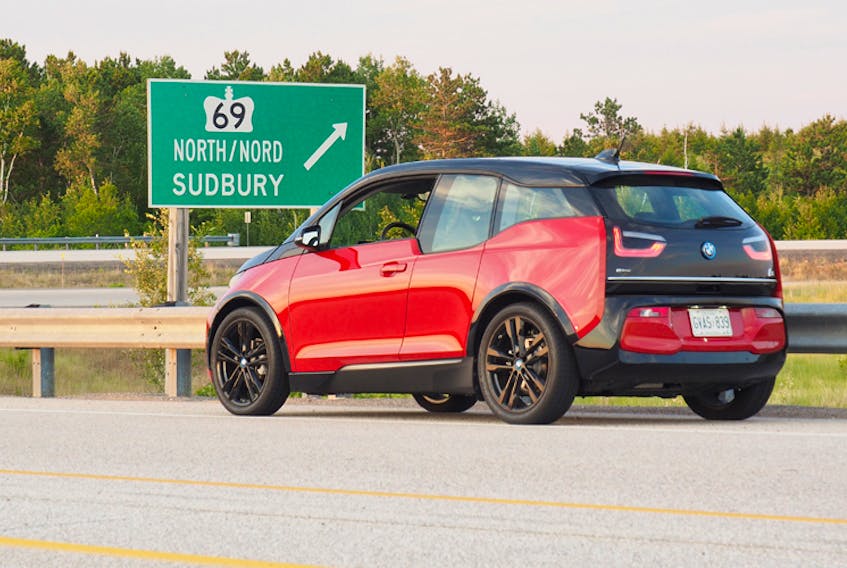Last week, I made my maiden electric vehicle (EV) voyage home to Sudbury, Ont., from the Greater Toronto Area, about 400 highway kilometres away.
It was the first time in nearly 15 years of reviewing 45+ cars per year that I’d ever driven an EV for more than a few minutes.
There are numerous reasons why, including that for years, many EVs just didn’t have enough range to make that long of a highway drive home feasible.
Further, charging infrastructure connecting Toronto to areas this far north has been patchy at best for years.
Lately, though, EV cars can go further than before and there are also more places to charge them along my route.
So, home I headed in one BMW i3 S and I’ll share the full review with you in a few weeks.
But, until then, I figured on sharing what I learned on my maiden EV voyage, which required driving a little EV, designed mostly for use in crowded cities, through a few hundred clicks of wide-open space, home and back.
Below, I’ll share the answers to the most common questions I got during a week at the wheel.
How far can that go?
The answer is subject to many variables and different for each EV model. A full battery charge in the BMW i3 S was good for about 170-180 kilometres of driving, though terrain, temperature, driving habits and use of the climate control system can all affect the range, perhaps by a dozen kilometres or so.
My figures were observed while cruising around 108 km/h on flat terrain with the air conditioner in its power-saving “eco pro” setting. Your results may vary.
How long does it take to charge?
The answer depends on what you plug the EV into, since charging happens at one of three levels depending on what you plug into.
Level-1 charging uses a household outlet at 120 volts. Here, recharging the i3 S battery from empty takes well over a day. Level-1 charging is ideal for top ups if you only run the battery down a little with daily errands.

A full battery charge in the BMW i3 S was good for about 170-180 kilometres of driving while cruising around 108 km/h on flat terrain with the air conditioner in its power-saving “eco pro” setting. (JUSTIN PRITCHARD)
For the in-town part of my test drive, level-1 charging filled the battery overnight, after about 30 kilometres of driving each day.
Level-2 chargers run at 240 volts. You can install one at home, and you’ll find them at malls, stores, parking garages and car dealers. I used the level-2 charger at Sudbury’s Science North science centre on occasion, with just an hour of charging bumping the charge level by a few dozen percent.
A full charge takes about four hours on level-2 — great if you’ll plug in while shopping, having supper, going to a movie, or going for a hike.
Level-3 chargers are your best friend for long distance travels, since they run at nearly 500 volts and plow power into the battery, fast.
I used level-3 chargers near the highway to fill the i3 S’s battery from nearly empty to nearly full, in about an hour.
Put another way, an hour of level-3 charging can add about 150 kilometres of range.
What does that cost?
On my drive, I found free charging stations at Ikea, car dealers, science centres, various malls, and the like. Other stations require payment by tapping your credit card, or using a special app in your phone (which lets you monitor the battery’s recharge state remotely). I only had to pay for charging at one of two level-3 stations I used. In this case, I added 170 kilometres of range for a cost of about $8.
What if the battery dies?
Like any car, once the power source is depleted, the car stops driving. Its just like running out of gas. EV charging stations are far less common than gas stations where I live, so I had to plan my route out ahead of time.
My tester had a gasoline range extender —a two-cylinder generator fed by a tiny fuel tank, that can provide another, perhaps, 120 kilometres of driving to get to the next plug. This is a generator only and does not drive the vehicle directly. Most EVs do not have a gasoline backup generator.
Would Justin Pritchard buy one?
Soon, but not quite yet. I like getting where I’m going fast, rather than stopping to charge along the way. Still, it’s hard to argue with the numbers — I drove about 1,200 kilometres that week for a total cost of about $21, including about $6 worth of gasoline used by the generator to get me to charging stations just outside of the battery’s range.
Some electric cars have more range than this i3 S and electric cars with even more range are coming soon. I’m interested, but considering my specific tastes and lifestyle, I’d wait a few more years.









